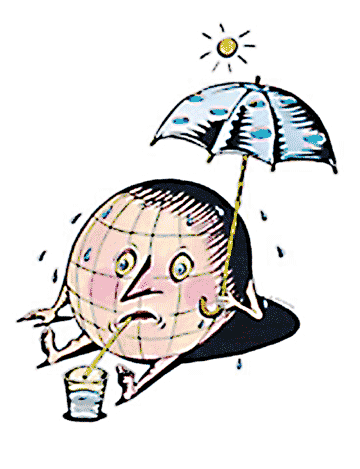 |
|||||||||||
|
|||||||||||
|
|||||||||||
Beating the OddsFollow these steps for a cooler futureby Carrie MadrenIt’s a high-stakes game of roulette that determines our world in 50 years. Will polar bears go extinct? Will Bay waters rise over City Dock? Will permafrost lose its permanence up north? In a game of numbers, percentages and chance, global warming takes its house cut out of our wagers. There’s now a 50 percent chance that Greenland will melt — if we can manage to stabilize our carbon dioxide emissions at 450 parts per million, says Environment Maryland director Brad Heavener. We’re at 380 now. Go higher than 450ppm, and Greenland’s chances go down. Our only chance to hold back the floodgate on global warming is to start cutting our greenhouse gas emissions. Now.
Crafting a PlanStaging an action plan to help us get there is Environment Maryland’s Blueprint for Action: Policy Options to Reduce Maryland’s Contribution to Global Warming released this month. “We will be affected much more drastically than other states around the country,” says Maryland state Sen. Paul Pinksy. “The Eastern Shore is barely above sea level.” Farmers across the Shore would lose land, says Pinsky, as would tourist destinations like Ocean City and urban centers like Baltimore and Annapolis. That’s soundly based on what we already know: that average global temperatures rose 1.4 degrees in the last century. The game plan is to curb our release of carbon dioxide, the biggest greenhouse gas that we emit. The biggest carbon polluters in Maryland are electricity generation and transportation, each accounting for 38 percent of our total emissions. The other 24 percent of our carbon comes from residential, industrial and commercial sources. Maryland has already passed laws that will give us known carbon cuts. The Clean Cars bill will cut our carbon dioxide emissions by 0.1 million metric tons by 2010; 3.5 million metric tons by 2020. More policies — like the nine championed in the new report — can save us more. If we follow these nine steps, say Environment Maryland and other supporters, then by 2020, Maryland’s emissions of carbon dioxide would fall 23 percent below 2006 levels. So the new plan would surpass by three percent our state goal of 20 percent reductions by 2020. We’re fighting an uphill battle, though. Maryland’s carbon emissions grew 16 percent from 1990 to 2004, as our human numbers continue to grow. “One of our greatest challenges continues to be growth,” says Secretary of the Environment Shari Wilson. “We want to have growth but in an environmentally responsible way. We’ll have to change the way we do some things.” Stepping DownEnvironment Maryland suggests these nine ways to slash our carbon emissions by 23 percent by 2020. First, we should require that 20 percent of electricity come from renewable sources — not just 9.5 percent. Second, up to 10 percent of our motor fuel should come from sources other than gasoline or diesel. Third, we need to cut vehicle miles traveled by curbing sprawl and strengthening mass transit. Fourth, we need to spend at least three percent of electric utility revenues on energy efficiency. Fifth, commercial buildings should combine heat and power, using the same energy to generate both electricity and heat. Sixth, Maryland government should increase energy efficiency in buildings and transportation. “We should only be using gas-efficient vehicles in the state fleet,” says Heavener. Seventh, we need to shorten our commutes. Perhaps, suggests the report, large employers should be required to develop programs to discourage single-passenger commuting. Eighth, strengthening our building energy codes would reduce both energy use and the amount of pollutants emitted to supply that energy. Finally, we should be driving on energy-saving replacement tires, which are not always available for consumers now. “It’s pretty ridiculous that we don’t do it now,” says Heavener. The Blueprint’s role, then, is to let us know that “it’s realistic to say we can follow science,” says Heavener. “So here is one set of options that would get us there.” Making It LawThis decisive action plan may soon influence, even become, law. Pinsky plans to introduce the Global Warming Solutions Act again in 2008, after it stalled this year. Many of those solutions will parallel points of this blueprint. “The bill next year will be similar,” Pinsky says, to this year’s. “Over time you reflect on something and improve it.” Exact percentages may not translate into next year’s Global Warming Solutions bill, but the momentum and ideas from the blueprint will. |
|||||||||||
|
|||||||||||
|
|
|||||||||||
|
© COPYRIGHT 2007 by New Bay Enterprises, Inc. All rights reserved. |
|||||||||||

